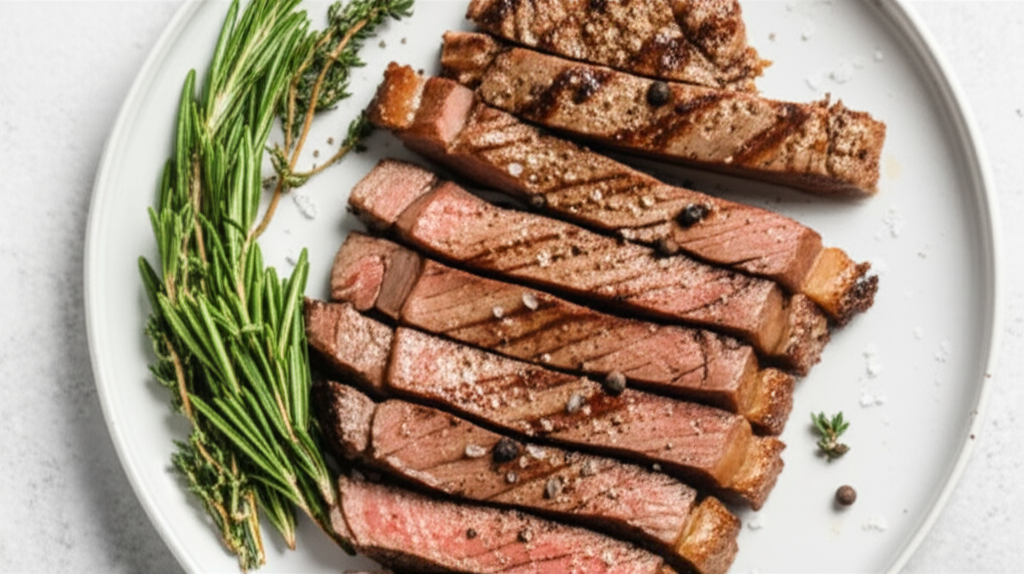Is Steak Good for Weight Loss – Yes, steak can be a part of a weight loss diet if chosen wisely and consumed in moderation. Leaner cuts, proper portion sizes, and balanced meals are key. Focus on quality ingredients and how you prepare it to maximize its benefits and minimize potential drawbacks.
Do you ever find yourself staring at your dinner plate, wondering if that delicious steak is a friend or foe on your weight loss journey? You’ve tried cutting out carbs, hitting the gym religiously, and even resorting to those bland meal replacement shakes. Yet, those stubborn pounds seem to have a mind of their own. It’s a common struggle, and the thought of giving up favorite foods like steak can feel incredibly daunting. But what if you didn’t have to? What if there was a way to enjoy a hearty steak while still progressing towards your health goals? This guide is here to unravel the truth about steak and weight loss, offering simple, practical advice to help you make informed choices.
Understanding Steak and Your Weight Loss Goals

When we talk about weight loss, the conversation often revolves around calorie deficits – burning more calories than you consume. This is the fundamental principle. However, it’s not just about the number of calories; it’s also about the quality of those calories and how they affect your body. Steak, a nutrient-dense food, can play a surprising role in this equation when approached correctly.
The key isn’t whether steak is “good” or “bad,” but rather how it fits into your overall dietary pattern. Think of it like this: your diet is a puzzle, and steak can be a valuable piece if you place it thoughtfully.
The Nutritional Powerhouse of Steak
Steak is more than just a tasty meal; it’s packed with essential nutrients that can actually support your weight loss efforts. Let’s break down some of the key benefits:
- Protein Power: Steak is an excellent source of high-quality protein. Protein is a superstar for weight loss for several reasons:
- Satiety: It helps you feel fuller for longer, reducing the urge to snack on less healthy options.
- Metabolism Boost: Your body uses more energy (calories) to digest protein compared to fats and carbohydrates.
- Muscle Preservation: During weight loss, maintaining muscle mass is crucial. Protein provides the building blocks for your muscles, ensuring you’re losing fat, not precious muscle. According to the USDA, a 3-ounce serving of lean beef can provide around 20-25 grams of protein.
- Iron Goodness: Red meat is a fantastic source of heme iron, which is highly absorbable. Iron is vital for energy production and transporting oxygen throughout your body. Feeling energized means you’re more likely to be active, further aiding weight loss.
- B Vitamins for Energy: Steak contains B vitamins like B12, B6, and niacin, which are crucial for converting food into energy and maintaining a healthy nervous system.
- Zinc for Health: This mineral plays a role in immune function and wound healing.
Visual Suggestion: An infographic comparing the macronutrient profile of different lean steak cuts versus other protein sources like chicken breast or fish.
Potential Pitfalls When Eating Steak for Weight Loss
While the benefits are clear, there are also aspects of steak consumption that could hinder weight loss if not managed carefully. Understanding these allows you to proactively avoid them.
- Fat Content: Not all steaks are created equal. Fattier cuts can be significantly higher in calories and saturated fat. Consuming too much saturated fat can have negative health implications and can easily contribute to a calorie surplus.
- Portion Distortion: The “standard” steakhouse portion can often be much larger than what’s recommended for mindful eating and weight management.
- Preparation Methods: How your steak is cooked matters immensely. Deep-frying or smothering it in creamy sauces will dramatically increase its calorie and fat content.
- Accompaniments: Steak is rarely eaten alone. Loaded baked potatoes, fries, and rich gravies can quickly turn a healthy-ish meal into a calorie bomb.
Choosing the Leanest Steak Cuts for Weight Loss
This is where the magic happens. Opting for leaner cuts of beef is your secret weapon for enjoying steak without derailing your diet. Leaner cuts have less visible fat and a lower overall fat content per serving.
Here are some of the best steak cuts to look for:
- Sirloin Steak: A great all-around choice, offering good flavor and tenderness with a relatively low fat content.
- Tenderloin (Filet Mignon): While often considered a premium cut, the tenderloin is surprisingly lean and incredibly tender.
- Round Steak: These cuts (like top round or bottom round) are leaner but can be tougher. Marinating and slow-cooking can make them incredibly delicious.
- Flank Steak: This is a lean, flavorful cut that’s excellent for marinating and grilling.
- Skirt Steak: Similar to flank, it’s lean and flavorful, though it can be a bit chewier.
What to Avoid (or consume very sparingly):
- Ribeye: Known for its marbling (fat running through the meat), ribeye steaks are typically higher in fat and calories.
- Porterhouse/T-bone: These are large cuts that often contain both a tenderloin and strip steak, meaning they can also pack a higher fat and calorie punch.
- Prime Rib: While delicious, the marbling and fattiness of prime rib make it a less ideal choice for weight loss.
A Rule of Thumb: Look for cuts where the fat is mostly around the edges and can be trimmed off, rather than marbling throughout the meat. The less marbling, the leaner the cut.
External Link Suggestion: Link to a reputable source like the USDA or a well-known nutrition site that lists the nutritional values of different beef cuts. For example, the USDA’s National Agricultural Library provides extensive data on food composition.
Portion Control is Key: Essential Guide
Even the leanest steak can contribute to weight gain if you eat too much of it. Understanding appropriate portion sizes is critical.
A standard serving size of cooked meat for weight management is generally considered to be around 3-4 ounces. This is roughly the size of a deck of cards or the palm of your hand.
Tip: When ordering steak at a restaurant, don’t be afraid to ask for a smaller portion if available, or plan to share a larger cut. At home, use a kitchen scale to accurately measure your steak before or after cooking. This habit can be a game-changer!
Visual Suggestion: A graphic showing common steak cuts next to a deck of cards for easy size comparison.
Healthy Cooking Methods for Steak
The way you prepare your steak can significantly impact its health profile. The goal is to enhance flavor without adding excessive calories or unhealthy fats.
- Grilling: This is a fantastic method. Grilling allows excess fat to drip away. Use marinades based on olive oil, vinegar, herbs, and spices for flavor.
- Broiling: Similar to grilling, broiling cooks steak from above, allowing fat to render out.
- Pan-Searing (with minimal oil): Use a good quality non-stick pan and just a tiny amount of heart-healthy oil (like olive oil or avocado oil) or even a cooking spray. You can also sear in a dry cast-iron skillet if you’re careful to prevent sticking.
- Baking/Roasting: For larger, leaner cuts like round steak, baking or roasting at a lower temperature after searing can result in a tender, flavorful meal.
What to Limit or Avoid:
- Deep-Frying: Adds a lot of unnecessary oil and calories.
- Creamy or Butter-Based Sauces: These are often high in fat and calories. Opt for lighter, tomato-based sauces, or rely on herbs, spices, and a squeeze of lemon.
- Excessive Seasoning Blends: Some pre-made steak seasonings can contain added sugar or salt.
Building a Balanced Steak Meal for Weight Loss
Steak should be just one component of a balanced meal. To create a weight-loss-friendly dish, pair your lean steak with plenty of vegetables and a moderate portion of complex carbohydrates.
Imagine this: a perfectly grilled 4-ounce sirloin, a large serving of steamed broccoli or a fresh salad with a light vinaigrette, and perhaps half a cup of quinoa or sweet potato. This combination provides protein, fiber, vitamins, and minerals, keeping you satisfied and well-nourished.
Below is a sample of how you might incorporate steak into your weekly meal plan without overdoing it.
| Day | Breakfast | Lunch | Dinner |
|---|---|---|---|
| Monday | Oatmeal with berries | Large salad with grilled chicken | Baked salmon with roasted asparagus |
| Tuesday | Scrambled eggs with spinach | Lentil soup with whole-wheat bread | Lean Sirloin Steak (4oz) with steamed green beans and a small sweet potato |
| Wednesday | Greek yogurt with nuts | Tuna salad (light mayo) on lettuce wraps | Chicken stir-fry with mixed vegetables |
| Thursday | Whole-wheat toast with avocado | Leftover chicken stir-fry | Lean turkey meatballs with zucchini noodles |
| Friday | Smoothie (fruit, spinach, protein powder) | Quinoa salad with chickpeas and vegetables | Lean Flank Steak (4oz) tacos on whole-wheat tortillas with salsa and avocado |
| Saturday | Oatmeal with berries | Large salad with hard-boiled eggs | Grilled lean pork tenderloin with a side salad |
| Sunday | Scrambled eggs with vegetables | Leftover grilled pork | Lean Round Steak (4oz) with a large portion of mixed roasted vegetables (broccoli, bell peppers, onions) |
Key Takeaways from the Meal Plan:
- Steak is included only 2-3 times per week.
- Portion sizes are kept to 4 ounces.
- Meals are balanced with lean protein, healthy fats, complex carbs, and plenty of vegetables.
- Variety is maintained with other lean protein sources.
Real-Life Success Stories
It’s easy to get lost in the theory, but real people are achieving their weight loss goals with balanced approaches that include foods like steak.
Take Sarah, for example. Sarah is a busy marketing manager who found it tough to stick to any diet plan. “I always felt deprived,” she explained. “When I started working with a nutritionist, she helped me see that I could still eat foods I enjoyed, like steak. We focused on lean cuts, smaller portions, and filling up on veggies. Instead of a huge ribeye with fries, I’d have a 4-ounce sirloin with a massive salad and some grilled zucchini. It felt manageable, and within four months, I’d lost 20 pounds and, more importantly, I felt like I could keep this lifestyle up long-term.”
Another success story comes from John, a construction worker who needed protein to keep him energized through his demanding days. “My old diet was all processed snacks and quick fixes that left me feeling sluggish by afternoon,” John shared. “My trainer suggested adding a lean steak meal once or twice a week. This gave me sustained energy, and because I felt more satisfied, I wasn’t reaching for junk food. Along with regular walks, I’ve lost 15 pounds and have more energy than ever.”
Integrating Steak Sensibly into Workouts
For those who are active, steak can be a valuable ally. Its high protein content is crucial for muscle repair and growth, especially after exercise. Consuming protein, like that found in steak, post-workout can aid recovery and help build the lean muscle that boosts your metabolism.
When is the best time to eat steak for weight loss and fitness?
- Post-Workout: Enjoying a lean steak meal within a few hours after a strength-training session can provide the amino acids your muscles need to repair and rebuild.
- Balanced Meal: As part of a balanced dinner, steak can help you feel satiated and prevent late-night snacking.
- Pre-Workout (with caution): For some, a very lean cut of steak a couple of hours before a workout can provide sustained energy. However, avoid eating it too close to exercise, as heavy meals can cause discomfort.
Remember, consistency in your diet and exercise routine is more important than the exact timing of a single meal. For more information on how nutrition supports physical activity, consider resources from organizations like the Academy of Nutrition and Dietetics.
FAQ: Is Steak Good for Weight Loss?
Can I eat steak every day if I’m trying to lose weight?
It’s generally not recommended to eat steak every day. While steak can be part of a healthy diet, it’s important to have variety in your protein sources and ensure overall calorie balance. Too much red meat can also lead to increased intake of saturated fat.
What is the healthiest way to cook steak for weight loss?
The healthiest methods involve cooking methods that allow fat to drain away, such as grilling, broiling, or pan-searing with minimal oil. Avoid frying or smothering the steak in heavy, creamy sauces.
How much steak should I eat to lose weight?
A typical portion size for weight loss is around 3-4 ounces (cooked weight). This is roughly equivalent to the size of a deck of cards. Focus on lean cuts and trim any visible fat.
Is grass-fed steak better for weight loss than grain-fed?
Grass-fed steak often has a slightly better fatty acid profile, with more omega-3s and conjugated linoleic acid (CLA), and can sometimes be leaner. While these differences are beneficial, the primary factors for weight loss remain portion size and overall calorie intake, regardless of the feeding method.
Can I lose weight without giving up steak?
Absolutely! As this guide shows, steak can be part of a successful weight loss plan. The key is choosing lean cuts, controlling your portion sizes, opting for healthy cooking methods, and balancing your meals with plenty of vegetables and other nutritious foods.
What vegetables should I pair with steak for weight loss?
Load up on non-starchy vegetables! Excellent choices include broccoli, spinach, asparagus, green beans, bell peppers, mushrooms, Brussels sprouts, and a large mixed green salad with a light vinaigrette. These add volume, nutrients, and fiber without significant calories.



